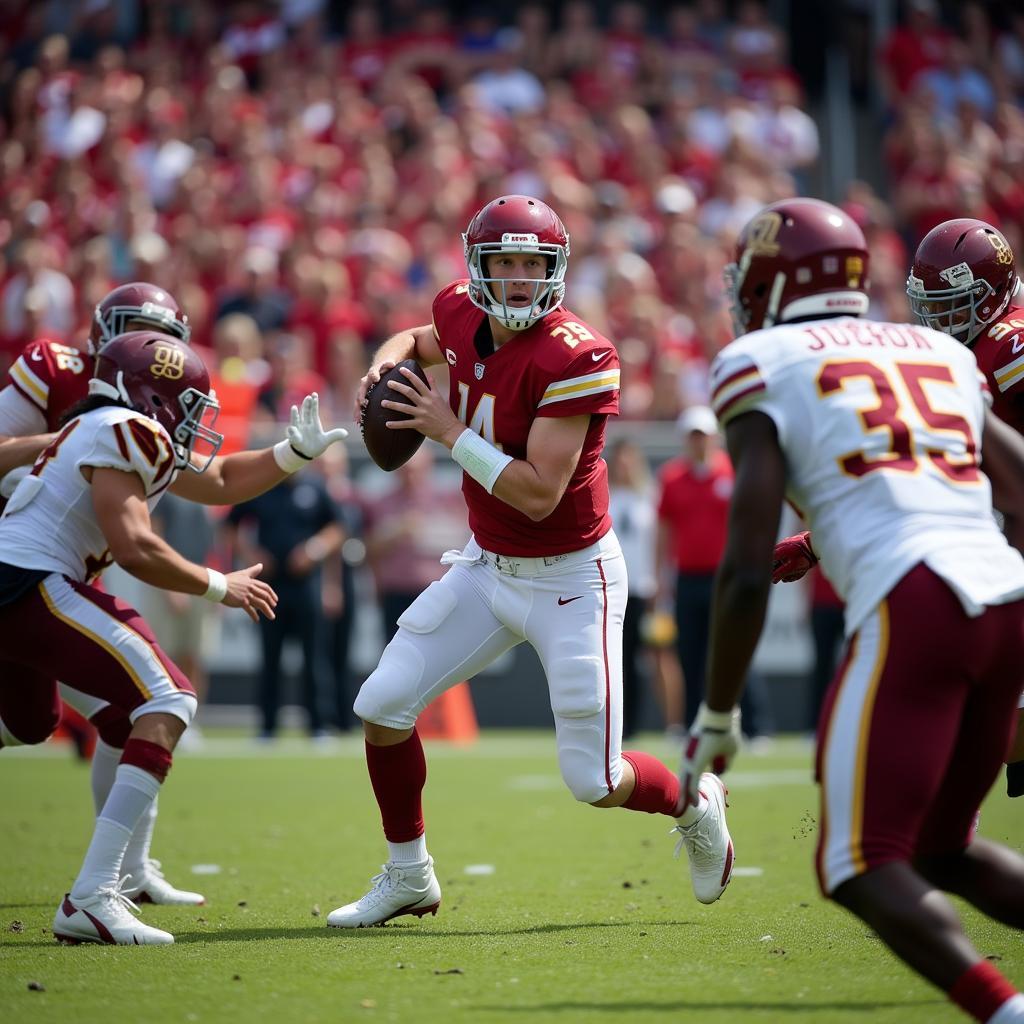Spread Offense Plays: Unleashing Offensive Firepower
November 10, 2024Spread Offense Plays are designed to stretch the defense horizontally and create space for skill players to operate. By utilizing a wider formation and distributing the ball to multiple receivers, spread offenses aim to exploit mismatches and generate explosive plays. This tactical approach has revolutionized football at all levels, from youth leagues to the professional ranks, and its influence continues to grow. Let’s delve into the intricacies of spread offense plays and understand how they can unlock a team’s offensive potential.
The core principle of spread offenses lies in creating numerical advantages in the passing game. By spreading out receivers, the offense forces the defense to cover more ground, leading to potential breakdowns in coverage. This allows quarterbacks to find open receivers for quick gains or deep strikes downfield. You can find more information about specific spread formations like the 5 wide offense here: 5 wide offense.
Understanding the Core Concepts of Spread Offense Plays
Spread offenses often operate out of shotgun formations, giving the quarterback a clearer view of the field and more time to read the defense. The increased spacing also creates opportunities for running backs to exploit one-on-one matchups with linebackers or defensive backs in the open field. This offensive style is characterized by its fast-paced tempo, keeping defenses on their heels and limiting their ability to substitute players or adjust their schemes.
Benefits of Utilizing Spread Offense Plays
- Creates Mismatches: Spreading the field forces defenses to spread out their personnel, often leading to favorable matchups for the offense.
- Enhances Passing Game: The wider field and spacing allow receivers to run more diverse routes and create separation from defenders.
- Opens Running Lanes: With fewer defenders in the box, running backs can find more space to operate.
- Increases Tempo: Spread offenses often employ a fast-paced, no-huddle approach, which can tire out defenses and limit their ability to make adjustments.
Key Variations and Adaptations of the Spread Offense
The spread offense isn’t a monolithic entity. There are numerous variations and adaptations tailored to different team strengths and coaching philosophies. Some teams may prioritize the passing game, utilizing quick passes and screens to move the ball downfield. Others might incorporate a strong running game, taking advantage of the spread formation to create running lanes for their backs. For example, the veer and shoot offense is a popular variation of the spread: veer and shoot offense playbook pdf.
Common Misconceptions about Spread Offenses
Some critics argue that spread offenses are overly reliant on the passing game and neglect the fundamentals of running the football. However, successful spread offenses often feature a balanced attack, using the pass to set up the run and vice versa. The key is to adapt the spread principles to fit the team’s personnel and exploit the opponent’s weaknesses. Another effective spread formation is the trips formation: trips formation plays.
“A well-executed spread offense isn’t just about throwing the ball all over the field,” says Coach John Smith, a veteran high school football coach with over 20 years of experience. “It’s about creating space, exploiting mismatches, and dictating the tempo of the game.”
 Spread Option Play
Spread Option Play
Designing Effective Spread Offense Plays
Creating successful spread offense plays requires careful planning and execution. Coaches must consider the strengths and weaknesses of their personnel, as well as the tendencies of the opposing defense. They must also design plays that exploit the spacing and create opportunities for big plays.
Essential Elements of a Successful Spread Offense
- Experienced Quarterback: The quarterback is the centerpiece of the spread offense, responsible for reading the defense, making quick decisions, and delivering accurate throws.
- Skilled Receivers: Receivers who can create separation, catch the ball reliably, and gain yards after the catch are crucial for the success of the spread.
- Versatile Running Backs: Running backs who can both run effectively between the tackles and catch passes out of the backfield are valuable assets in a spread offense.
“The beauty of the spread offense is its flexibility,” adds Coach Maria Garcia, a renowned college football analyst. “It can be adapted to fit any team’s personnel and exploit any defense’s weaknesses.”
Conclusion
Spread offense plays have become a dominant force in modern football, offering a dynamic and versatile approach to attacking defenses. By spreading the field, creating mismatches, and dictating the tempo, spread offenses can unlock a team’s full offensive potential. While there are various adaptations and strategies within the spread offense, the core principle remains constant: create space, exploit weaknesses, and score points. Resources like a double wing t offense playbook or a split back shotgun offense playbook pdf can offer more detailed insights: double wing t offense playbook and split back shotgun offense playbook pdf.
FAQ (Frequently Asked Questions)
-
What is the main purpose of spread offense plays?
To stretch the defense and create space for skill players. -
What are the key benefits of using spread offense plays?
Creating mismatches, enhancing the passing game, opening running lanes, and increasing tempo. -
What are some common misconceptions about spread offenses?
That they are solely reliant on the passing game and neglect the running game. -
What are the essential elements of a successful spread offense?
An experienced quarterback, skilled receivers, and versatile running backs. -
How can I learn more about specific spread offense formations and plays?
By researching playbooks and consulting with experienced coaches. -
What are some different types of spread offenses?
The Air Raid, the Run and Shoot, and the Pistol offense are a few examples. -
What are some good resources for learning more about spread offense plays?
Coaching clinics, online forums, and instructional videos.
For any assistance, please contact us: Phone: 0915117113, Email: [email protected] Or visit us at: Group 3, Binh An Hamlet, Phu Thuong Commune, Vietnam, Binh Phuoc 830000, Vietnam. We have a 24/7 customer support team.